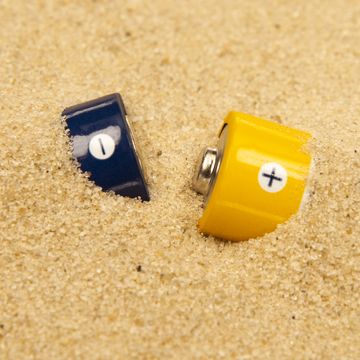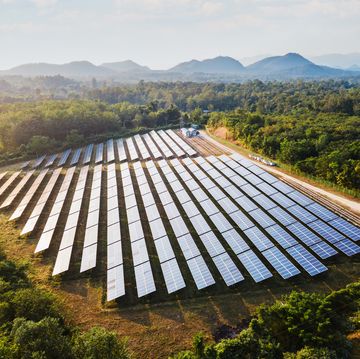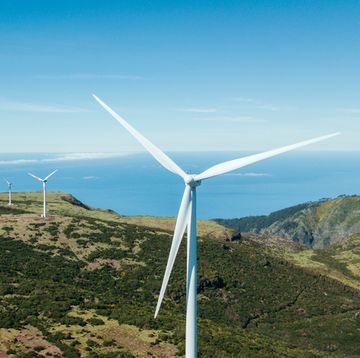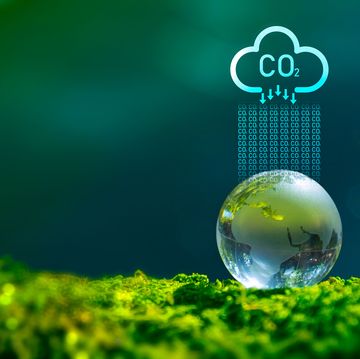A few days ago we covered a group of scientists who found a way to turn CO2 into ethanol. The idea of an elegant solution for carbon emissions sparked a huge amount of enthusiasm—it's already become Popular Mechanics' most popular story of 2016, in fact. So we sat down with Adam Rondinone, one of the scientists behind the discovery, for a more in-depth look at this technology.
Popular Mechanics: A lot of people on the internet have been really excited about what your team has discovered.
Adam Rondinone: We're surprised but very happy about the attention. It's nice. Scientists don't often get a lot of attention for what they do, especially in certain fields like chemistry.
PM: First, could you explain what you've discovered?
AR: I work for Oak Ridge National Laboratory, which is a government-owned, government-funded research institution. As part of our mission, we do research in nanotechnology. It just so happens that our group, and me personally, were focused on catalysis. Catalysts are things that make reactions go more easily. We were studying a type of catalyst that operates with electricity, called an electrocatalyst, and we were attempting to use the principles of nanotechnology to control a chemical reaction.
Chemical reactions tend to proceed along multiple steps. Like any complex process, you'll have step one, step two, step three, and so on. Essentially, we were trying to arrange—or texture—a reactive surface in such a way that the steps would take place in different places, or occur on different reactive sites. Our hope was that we'd be able to control a complicated reaction.
We picked carbon dioxide. Using electricity to take carbon dioxide and make it into something useful is an important concept, and it's one that's being studied all over the world. We were just going about it in a slightly different way. We took carbon dioxide and were attempting to electrochemically reduce it, which means we take the oxygen away and replace it with hydrogen to make something like methane.
We were doing this reaction, and to our surprise, we discovered we were making ethanol. And that's where the "accidental" part of this comes in. It wasn't so much accidental in the sense that we tripped and fell on it, but it was an unexpected outcome, and a pleasant one.
So this is really the first good example of an electrochemical reaction where you take carbon dioxide and make ethanol from it. People have shown in the literature already how to make methane with very high yield, and now we're approaching the yields of methane but we're doing it with a liquid fuel. And that's very exciting.
PM: So why did you end up with ethanol instead of methane?
AR: The real key here is that ethanol [C] has two carbons. Somewhere along the way, you have to take two carbon dioxide molecules that were reacting and they have to couple together.
We believe what happens is a carbon dioxide molecule loses an oxygen. That's the first step. So you end up with carbon monoxide [CO]. Then, if two adjacent carbon monoxides react together, then you form a dimer. The two carbon atoms are bonded directly together. Then, if you take those carbon atoms and you continue to reduce them, so you remove another oxygen and replace it with hydrogen. Then you end up with ethanol.
PM: Can you talk about the efficiency of this process in turning CO2 to ethanol? Also, what are the byproducts and how much electricity does it use?
AR: We've looked at the yield and selectivity in depth. So let's look at it in a couple of different ways.
Let's start with 100 electrons. We push 100 electrons across this catalyst and allow it to react. We have a yield of 63 percent. This means that, of those 100 electrons, 63 of them will end up stored as ethanol. Then the rest go to something else, primarily hydrogen.
You can also look at the selectivity from the perspective of carbon dioxide. So if you take 100 carbon dioxide molecules and you allow them to react, roughly 84 of them will end up as ethanol. The rest become something else, whether it's carbon monoxide or formic acid or methane.
We're really pleased with 63 and 84 percent yields. These are high for this type of reaction, so we're very happy about that.
Now let's talk about the energy efficiency. The energy efficiency is essentially the energy you store divided by the energy you put into the reaction. We haven't really investigated this, but we're ballparking it around 20 percent, which is low. This is why, in the paper, we actually said that the overpotential (which defines the energy efficiency) is probably too high for the catalyst as it currently stands to be used commercially.
Now, that's against, say, corn ethanol. For other applications it actually may be very competitive. However, that would be the sort of thing that we'd be looking at in the future. We've got a better handle on the mechanism and how it works, so now there are strategies that can be developed to hopefully raise that energy efficiency.
PM: What are those methods for raising the energy efficiency?
AR: Some of that is research, and we don't want to give all of it away, but we can mention a few things.
Perhaps one of the most obvious is, there are actually two reactions going on at once with this catalyst. We are electrochemically reacting carbon dioxide to get the carbon, and we are electrochemically reacting water to get the hydrogen. And they're happening together on the same catalyst.
While it's scientifically interesting and somewhat beneficial that those things occur together, you could actually separate those apart. You could have a better catalyst for water electrolysis and then feed the hydrogen in directly, along with CO2, and allow it to react. That's probably a good starting point for increasing the energy efficiency.
PM: You also mentioned that there are already some applications where this could be competitive. Could you talk about some of the ways this technology could be used?
AR: Well, everybody jokes about nano-beer. That's not our role. But we've had business interests on that side.
However, if someone was interested in making chemical feedstocks or making ethanol under a different regulatory framework—like if there was a price on carbon—then this could suddenly become very competitive. If we were going to do this right now, against gasoline and E85 and corn-based ethanol, it's probably not competitive. But if you were really interested in closing the carbon cycle, and when you think about cap and trade or a carbon tax, then it could become competitive.
There are times when electricity is really cheap, like at night when the windmills are blowing hard and utility doesn't need the electricity. That's why we propose you could use this as an opportunity to essentially suck up extra electricity and put it somewhere in the form of ethanol, which can be distributed and used as fuel.














